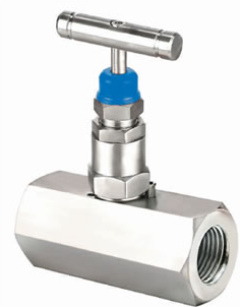Needle Valve
As a Needle Valve Supplier in Dubai, we provide precision small-bore isolation and metering valves for instrumentation, sampling, and impulse lines. These valves use a fine tapered stem for accurate flow regulation and reliable shutoff in compact installations. Commonly found in oil & gas, power, water treatment, and chemical plants, needle valves are valued for their ability to meter, calibrate, and safely vent process media in high-pressure and corrosive environments.
How Needle Valves Work
Needle valves use a fine-threaded, multi-turn stem with a tapered tip that mates into a seat:
- Flow regulation: Turning the stem advances the tip into the seat to restrict flow or retracts it to open the passage.
- Non-rotating stem tip: Reduces galling and wear, ensuring consistent shutoff and long service life.
- Sealing: Packing (PTFE or graphite) seals around the stem, while a back seat protects packing when the valve is fully open.
- Bonnet options: Screwed, union, and bolted bonnets are available for different pressure ranges and ease of maintenance.
Benefits
- Precise, repeatable regulation for instruments, gauges, and sampling
- Bubble-tight shutoff with metal or soft seat options
- Long service life from non-rotating stem designs
- Compact body for panel, manifold, and close-coupled mounting
- Wide material range for sour gas, seawater, and high-temperature duties
- Low maintenance with readily available spares and service kits
- Effective as instrument valves and gauge isolation valves in analyzer and transmitter lines
Industries Served
Our experience as a Needle Valve Supplier in Dubai extends to:
- Oil & Gas: wellhead panels, gauge isolation valves, chemical injection skids
- Power Generation: steam/water sampling, analyzer shelters, impulse lines
- Water & Desalination: RO skids, product analyzers, plant utilities
- Petrochemical & Chemical: reactor instrumentation, instrument valves for corrosion monitoring
- District Cooling & Industrial Utilities: chilled water and process control loops
- Marine & Offshore: topsides instrumentation, seawater service with CRAs
Technical Specifications
- Size range: 1/8 in to 1 in (DN 6 to DN 25)
- Pressure ratings: up to 6,000 psi (413 bar); high-pressure models to 10,000 psi (690 bar)
- Temperature range: −54 °C to +260 °C (higher with graphite packing and alloy trims)
- Orifice/Cv: micro-orifice to high-Cv trims for venting or blow-down service
- End connections: NPT (ASME B1.20.1); BSPP/BSPT (ISO 7-1); double-ferrule tube ends (6–25 mm / 1/4–1 in); socket-weld on request
- Seats & tips: metal-to-metal or soft-seat (PTFE/PCTFE); V-tip, regulating tip, or shutoff tip
- Bonnet styles: screwed, union, bolted; anti-tamper lock cap available
- Packing: PTFE standard; graphite for higher temperatures; live-loaded options
- Compliance: NACE MR0175 / ISO 15156 for sour service when specified
Design Standards
- MSS SP-99 – instrument valves
- ASME B16.34 – pressure-temperature design ratings
- ASME B1.20.1 – NPT threads; ISO 7-1 – pipe threads
- ISO 15848 – fugitive emissions where required
- Compatible with industry double-ferrule tube fitting standards
Inspection and Testing
- Hydrostatic and pneumatic shell/seat tests to ISO 5208 / EN 12266
- Helium leak testing available for critical services
- Functional torque and stroke checks; proof and burst testing by design
- PMI, hardness, and visual inspection per specification
- Material traceability with EN 10204 3.1 or 3.2 certificates
- Third-party inspection available when specified
Body and Trim Material Compatibility
| Category | Material / Grade | Standards / Grades | Typical Applications |
|---|---|---|---|
| Barstock Stainless | 316 / 316L | ASTM A479 / A276 | General service, seawater, analyzer lines |
| Super Austenitic | 6Mo (F44 / 254SMO) | ASTM A182 / A276 | High chlorides, desalination units |
| Duplex / Super Duplex | 2205 (F51), 2507 (F55) | ASTM A182 | Seawater and chloride-rich duties |
| Nickel Alloys | Monel 400, Inconel 625 | ASTM B164 / B446 | Sour gas, high temperature, aggressive media |
| Hastelloy | C276 | ASTM B574 / B564 | Strong oxidizers and severe corrosion |
| Carbon Steel | A105 / LF2 | ASTM A105 / A350 | Non-corrosive utilities, instrument air |
| Bronze / Brass | C83600 / DZR Brass | ASTM B62 / CW602N | Low-chloride utilities, specific project needs |
| Soft Seats / Packing | PTFE, PCTFE, Graphite | Manufacturer Spec | Sealing elements for low torque and high temperature duty |
Special Features
- Non-rotating stem tips to minimize galling and extend seat life
- Anti-tamper caps for secure settings on critical instruments
- Integral vent or bleed ports for safe depressurization
- Compact handles and panel-mount options for analyzer racks and shelters
- Oxygen cleaning and degreasing available when specified
- Color-coded handles and tagged flow direction for quick identification
- Low-emission packing options for ISO 15848 compliance
- Customisation available for end connections, bonnets, trims, and handle styles to suit project standards
Showing the single result



